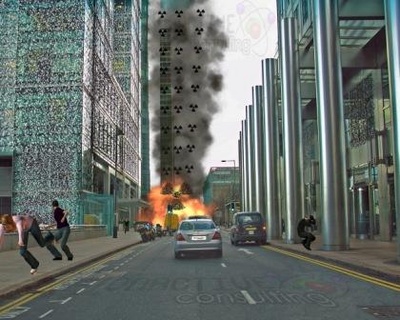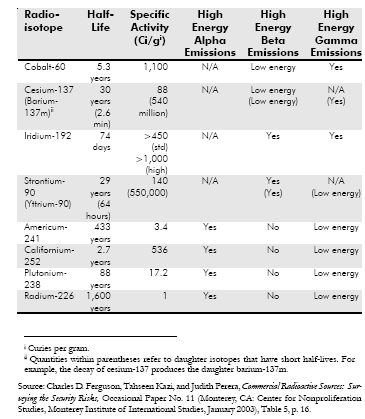15: Radiological Terrorism
- Page ID
- 19590
While attacks by terrorists have not involved the use of non-fissionable, radioactive materials, they have nevertheless increased concerns over the possibility of individuals or groups acquiring these materials. Radiological materials have the potential to be used as weapons as either radiological dispersal devices (RDD) or radiation emission devices (RED). An RDD is a device that disperses radioactive material into the environment. By contrast, an RED employs a stationary radioactive source to expose victims to high levels of radiation. These devices are often referred to as “weapons of mass disruption” in contrast to fission devices, which are known as a “weapons of mass destruction” due to their massive impact on the targets. No successful radiological attack has occurred to date, although intelligence data reveals that Al Qaeda has expressed an interest in acquiring radioactive materials, and RDDs planted by Chechen rebels were disarmed in 1995 and 1998.

Radiological Terrorism. A Simulated Radiological Attack (Courtesy of Ionactive Consulting)
Radiation Emission Devices
An RED is a radioactive source placed or concealed in a location where it can deliver radiation to victims. The source might go undetected for a long period of time. An accident that took place in Goiania, Brazil in 1987 illustrates the possible effects of a RED attack. An abandoned medical therapy unit containing Cs-137 was looted by two people for scrap metal. They opened the unit, exposing themselves and the surrounding population to high levels of radiation. This resulted in 112,800 people being examined, 249 contaminated, 20 hospitalized, 4 deaths, and contamination of 2,000 square meters of the environment.
A case involving the targeting of a specific individual with an RED occurred in London in 2006. Alexander Litvinenko, a Russian ex-KGB agent, died from radiation poisoning three weeks after ingesting tea containing radioactive polonium-210. Its 138 day half-life results in a high rate of alpha particle emission, leading to lethal doses from ingestion of a small amount of this isotope. It is produced in nuclear reactors for use in devices that eliminate static electricity in machinery.
Radiation Dispersal Devices
The use of an RDD would likely be more dramatic than an RED, creating instantaneous, widespread panic. While many methods can be used to spread radioactive materials, devices using dynamite, TNT, or other chemical explosives are thought to be the most likely means of dispersal. If the RDD employs a chemical explosive, the initial effect would be from the blast used to scatter the radioactive materials. The energy released by this small “dirty bomb” is dwarfed by the enormous amount of energy in the form of heat and primary radiation from a nuclear explosion. Significant contamination from the dispersal of radioactive material from an RDD would likely be limited to a few city blocks or at most several square miles depending on the explosive employed and the weather conditions. By comparison, the radioactive fallout from the fission products from a nuclear detonation could spread over hundreds of square miles. However, an RDD attack would be locally disruptive, cause widespread panic, and contaminate property, requiring a difficult, expensive cleanup.
Figure 1 shows the long-term results of a simulated “dirty bomb” attack on Washington, DC using a device containing cesium-137 and ten pounds of TNT. The initial passing of the cloud would be relatively harmless but residents in the affected area would stand increased chances of developing cancer due to long term effects. Within the inner ring there would be one cancer death per 100 people due to residual radiation. This falls to one death per 100 people in the middle ring and one death in 10,000 people in the outer ring. These mortality figures represent a 5%, 0.5%, and 0.05% above normal deaths from cancer. The U. S. Environmental Protection Agency recommends decontamination or destruction of contaminated material within the outer circle.

Sources of Radioactive Materials
Sources of radioactive materials for use in radiological devices are widely available. Radioisotopes have widespread applications in medicine, industrial radiography, oil well logging, and scientific research. Most radioisotopes are produced in research reactors and only a small number have properties to qualify them as components of an RDD or RED. Spent fuel from commercial nuclear power reactors also contains radioactive isotopes. However, materials from research reactors might be targeted in preference to spent reactor fuel because of lighter security measures, lower levels of radioactivity, and smaller volumes of material.
Radioactive isotopes with extremely short half-lives are unsuitable for use in RDDs and REDs because they cannot contaminate an area for any appreciable period of time, while isotopes with very long half-lives emit their radiation slowly, resulting in very low doses. The eight radioisotopes listed in Table 1 pose the greatest security risks. All are present in commercial radioactive sources, with seven produced in nuclear reactors and one, radium-226, occurring in nature. These isotopes with half-lives ranging from months to decades pose the greatest health risks because they emit all or most of their radioactivity during the typical life span of a human. Cesium-137 and strontium-90 are particularly dangerous since their chemical properties are similar to potassium and calcium, allowing them to be ingested by plants and animals and stay resident in living tissue for relatively long periods of time. The medical effects and doses associated with the different radioactive emissions presented in Table 1 are discussed in an accompanying unit of this case study (the Biological Effects of Nuclear Radiation).
Table 1 – Radioisotopes that Pose the Greatest Security Risks

(From Ferguson, C. and Potter, W., The Four Faces of Nuclear Terrorism, Center for Nonproliferation Studies, Monterey, CA, 2004, p. 263.)
Other factors are also important considerations in the construction of an effective device. These include the amount of radioactive material and its physical state, as well as the ease of acquisition and transport. For example, cesium-137, usually found in the form of powdered cesium chloride, is a much better material for an RDD than sources like solid pellets of cobalt-60, which are much more difficult to disperse effectively.
Materials with high enough levels of radioactivity to create an RDD are found in radioisotope thermoelectric generators, medical radiation equipment, industrial radiography instruments, food and blood irradiators, and sources used in research applications. Table 2 gives the identities and activities of radioisotopes in high risk sources. In addition, some of these might be used intact as REDs, depending upon their size and portability. For example, a small (2 centimeter diameter) coba chloride taken from a food irradiation device could be introduced into a public water supply.
Table 2. High-Risk Radioactive Sources

(From Ferguson, C. and Potter, W., The Four Faces of Nuclear Terrorism, Center for Nonproliferation Studies, Monterey, CA, 2004, p. 266.)
Medical Impacts of a Radiological Attack
In addition to casualties from the initial RDD explosion, persons in the immediate area could be subjected to high levels of ionizing radiation. However, as the radioactive material spreads, it becomes less concentrated and thus less harmful. In the case of a concealed RED, individuals do not realize they have been exposed to the radiation until the onset of symptoms associated with the exposure or the discovery of the source. Prompt detection of the type of radioactive material employed is essential to minimizing the effects of either event. Immediate effects on individuals of exposure to ionizing radiation would be determined by the amount and type of radiation absorbed, which in turn depends upon the distance from the source, duration of exposure, and whether the radioactive material was absorbed by the skin, inhaled or ingested.
Medical effects from exposure to radiation are classified as either deterministic, those which cause specific symptoms that are directly proportional to the amount of high-dose ionizing radiation over a relatively short period of time from seconds to days or stochastic, those which occur unpredictably over time in persons exposed to lower doses. In the case of deterministic effects, victims may experience loss of organ function, nausea, skin burns, and hair loss for moderately high doses, and possibly death for very high doses. With stochastic effects, persons exposed to low doses of radiation would not know whether long term health effects such as development of cancer were due to radiation exposure to an RDD or RED or just the occurrence of these disorders in a normal population.
Conclusion
While the physical effects of a radiological attack would be localized, the psychological effects could be widespread. Educating the public about the risks of such attacks is the best method of preventing the panic desired by the attackers. In the event of an attack, effective communication with the public can minimize its effects, both physical and psychological. Finally, increased monitoring of radioactive materials by local, national, and international governments and organizations can decrease the probability of acquisition of these materials by potential attackers.
Complete Bibliography on Radiation from the Alsos Digital Library for Nuclear Issues
Contributors
Frank A. Settle (Washington and Lee University)


